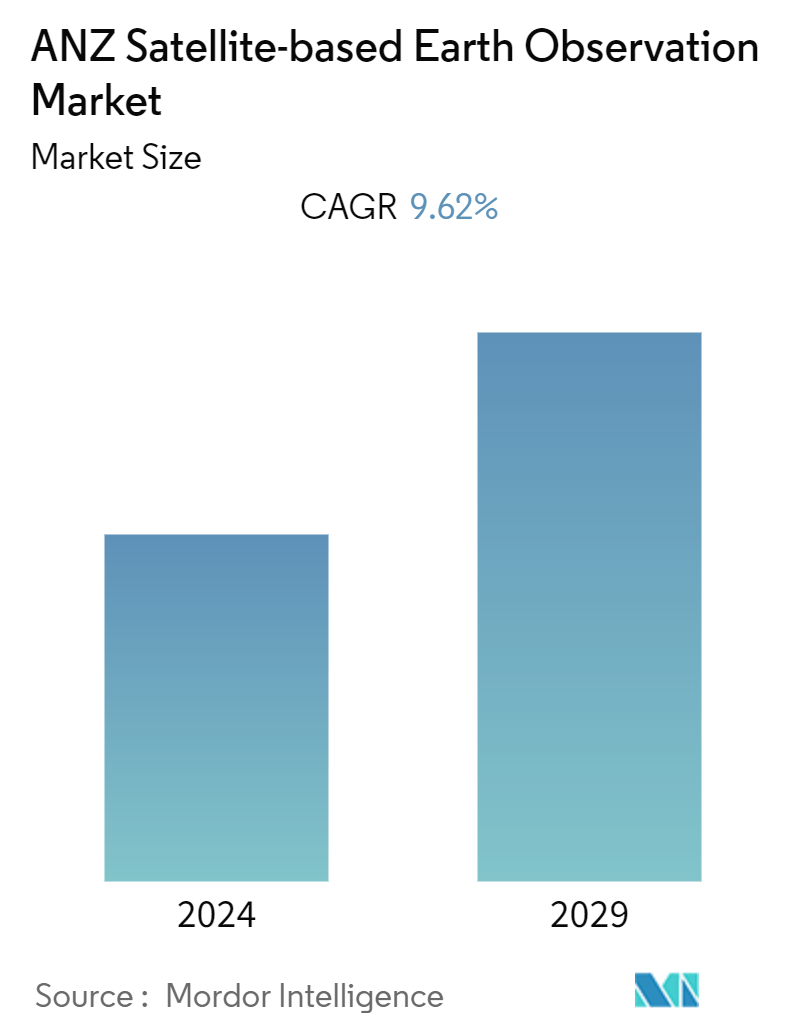Market Size of ANZ Satellite-based Earth Observation Industry

| Study Period | 2019 - 2029 |
| Base Year For Estimation | 2023 |
| Forecast Data Period | 2024 - 2029 |
| Historical Data Period | 2019 - 2022 |
| CAGR (2024 - 2029) | 9.62 % |
| Market Concentration | Medium |
Major Players
*Disclaimer: Major Players sorted in no particular order |
ANZ Satellite-based Earth Observation Market Analysis
The ANZ Satellite-based Earth Observation Market is expected to register a CAGR of 9.62% during the forecast period.
The region's climate services and urban development sector use EO data from remote sensing to improve community safety, environmental research, and policymaking, significantly driving the market demand in ANZ.
- Deploying earth observation satellites in the ANZ region provides valuable data on various geophysical variables consistently, and these data-based services have become a part of an evidence-based process that helps make decisions about public policy, which have significant social and economic benefits, creating a demand for the vendors in ANZ.
- Bushfires and grassfires are common throughout Australia, and that can be identified by the earth observatory data, which would help the climate service organizations to have the information about the cause, impact, and reason for the forest fires in the region, which is fueling the demand for the EO data and value-added services.
- Government support in developing Earth Observatory hubs for infrastructure, climate control, disaster management, coastline monitoring, urban development, etc., drives the market growth in Australia and New Zealand. For instance, in September 2022, The Queensland Earth Observation Hub was established as a partnership between the Queensland Government and the SmartSat Cooperative Research Centre. This hub would assist EOMAP, a satellite-based mapping and monitoring vendor, in expanding its services in Queensland to help the state in urban development by developing a coastline monitoring system for climate changes and storms.
- However, the major challenge associated with using earth observation data is the cost of acquiring and processing it, which can be prohibitive for some businesses due to budget constraints. In addition, interpreting and analyzing the data necessitates considerable expertise and computational power. Additionally, the information depends on various security and protection options, which may limit its utility in particular applications.
ANZ Satellite-based Earth Observation Industry Segmentation
ANZ Satellite-based Earth Observation Market includes the EO data and Value added services provided by the market vendors in the region, which get the information through payloads (Scientific and technological instruments) attached to satellites to acquire imaging data about the Earth's characteristics. Additionally, the images are processed and analyzed to give insights from the data that can be applied to various fields and applications.
ANZ satellite-based earth opbservation market is segmented by type (earth observation data, value added services), satellite orbit (low earth orbit, medium earth orbit, geostationary orbit), and end-user (urban development and cultural heritage, agriculture, climate services, energy and raw materials, infrastructure). The market sizes and forecasts are provided for a value of USD for all the above segments.
| By Type | |
| Earth Observation Data | |
| Value Added Services |
| By Satellite Orbit | |
| Low Earth Orbit | |
| Medium Earth Orbit | |
| Geostationary Orbit |
| By End-use | |
| Urban Development and Cultural Heritage | |
| Agriculture | |
| Climate Services | |
| Energy and Raw Materials | |
| Infrastructure | |
| Others |
ANZ Satellite-based Earth Observation Market Size Summary
The ANZ Satellite-based Earth Observation Market is experiencing significant growth, driven by the increasing demand for satellite data services in climate services and urban development. The region's governments are actively supporting the development of Earth Observation hubs, which are integral to infrastructure, climate control, disaster management, and urban development initiatives. These hubs, such as the Queensland Earth Observation Hub, facilitate the expansion of satellite-based mapping and monitoring services, contributing to the market's expansion. The use of Earth Observation data is crucial for understanding and managing environmental challenges, such as bushfires, and is becoming an essential tool for evidence-based public policy decision-making. Despite the high costs and expertise required for data acquisition and processing, the market is bolstered by substantial government investment and private sector involvement, which are enhancing the region's satellite operations and Earth observation capabilities.
The market landscape in Australia and New Zealand is characterized by a moderate level of consolidation, with major players like Airbus SE, NEC Corporation, and Arlula Pty Ltd leading the charge. These companies are forming strategic partnerships to enhance their service offerings and expand their market presence. The region's agricultural sector is also benefiting from satellite-based Earth Observation data, which is driving demand for technology that enhances climate resilience and productivity. Collaborative efforts, such as those between the New Zealand government and NASA, are further propelling market growth by focusing on critical areas like environmental monitoring and biodiversity. Additionally, innovations in data processing, such as Spiral Blue's Space Edge One computer, are set to revolutionize the capabilities of Earth Observation data services in the region, indicating a promising future for the market.
ANZ Satellite-based Earth Observation Market Size - Table of Contents
-
1. MARKET INSIGHTS
-
1.1 Market Overview
-
1.2 Industry Attractiveness - Porter's Five Forces Analysis
-
1.2.1 Bargaining Power of Buyers
-
1.2.2 Bargaining Power of Suppliers
-
1.2.3 Threat of New Entrants
-
1.2.4 Threat of Substitutes
-
1.2.5 Intensity of Competitive Rivalry
-
-
1.3 Industry Value Chain Analysis
-
1.4 Assessment of the Impact of COVID-19 on the Market
-
-
2. MARKET SEGMENTATION
-
2.1 By Type
-
2.1.1 Earth Observation Data
-
2.1.2 Value Added Services
-
-
2.2 By Satellite Orbit
-
2.2.1 Low Earth Orbit
-
2.2.2 Medium Earth Orbit
-
2.2.3 Geostationary Orbit
-
-
2.3 By End-use
-
2.3.1 Urban Development and Cultural Heritage
-
2.3.2 Agriculture
-
2.3.3 Climate Services
-
2.3.4 Energy and Raw Materials
-
2.3.5 Infrastructure
-
2.3.6 Others
-
-
ANZ Satellite-based Earth Observation Market Size FAQs
What is the current ANZ Satellite-based Earth Observation Market size?
The ANZ Satellite-based Earth Observation Market is projected to register a CAGR of 9.62% during the forecast period (2024-2029)
Who are the key players in ANZ Satellite-based Earth Observation Market?
Arlula Pty Ltd, LatConnect60 Pty Ltd., Airbus SE, NEC Corporation and Go2Q Pty Ltd are the major companies operating in the ANZ Satellite-based Earth Observation Market.

